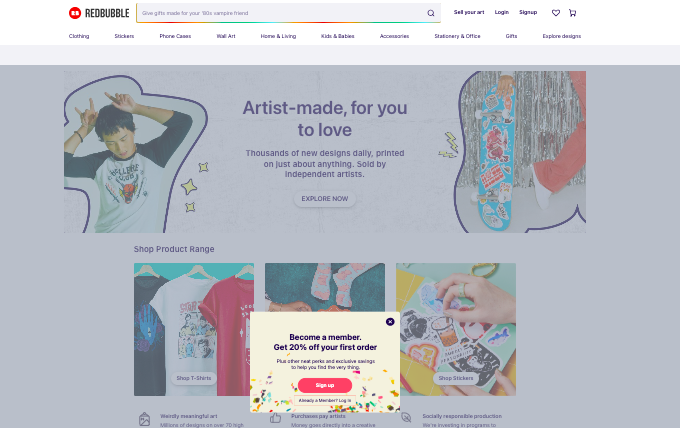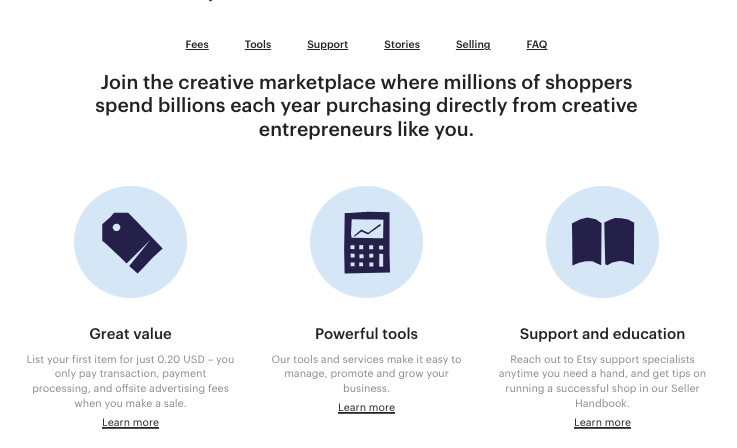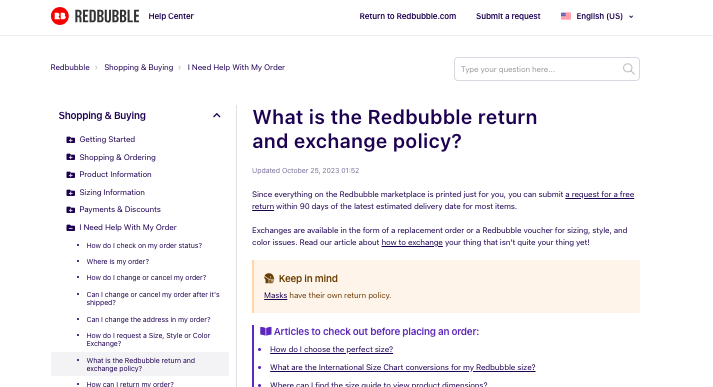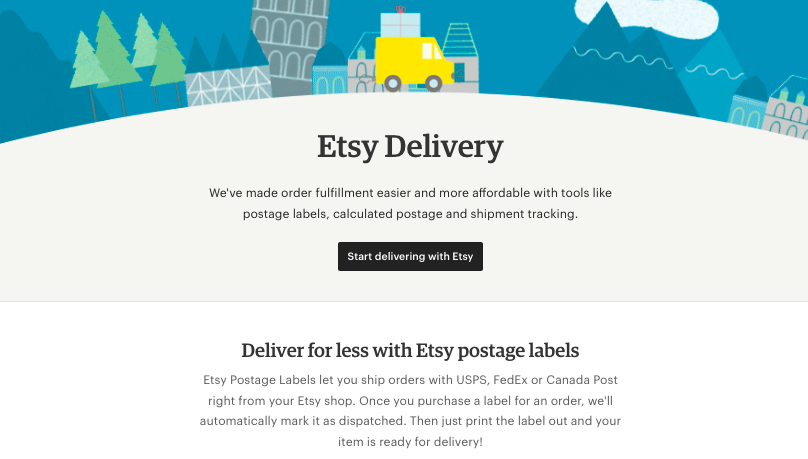If you’re an artist looking to sell your creations online, you’ve likely come across two popular platforms: Redbubble and Etsy.
Both of these online marketplaces offer opportunities for creative individuals to showcase and sell their art and unique products. But how do they compare?
In this comprehensive comparison, we’ll delve into the key differences between Redbubble and Etsy, helping you determine which platform might be the best fit for selling your art.
Also Read: Best Printful Alternatives For Etsy
Key Takeaways
- Redbubble and Etsy are online marketplaces for artists to sell their art and unique products.
- Redbubble offers easy account setup, while Etsy has a longer registration process requiring the listing of your first product.
- Redbubble focuses on print-on-demand products, while Etsy allows sellers to list handmade, vintage, and craft items.
- Redbubble handles production and shipping, while Etsy sellers are responsible for these aspects.
- Both platforms have different pricing structures and fees, so it’s essential to consider the potential profit margins.
Getting Started: Signing Up and Listing Items for Sale
To start selling on Redbubble, all you need is a simple account setup, while on Etsy, the registration process is a bit longer. However, Etsy requires you to list your first product during the registration process.
Redbubble makes it easy for artists to upload and customize their designs, allowing you to showcase your artwork effortlessly.
On the other hand, Etsy provides more detailed listing options, giving you the opportunity to include product videos, variations, and materials information. This additional information helps potential buyers make informed decisions about your creations.
Product Types and Selling Process
When it comes to selling your art, understanding the product types and selling process can greatly impact your success.
In this section, we’ll explore the variety of products available on Redbubble and Etsy, as well as the selling process on each platform.
If you’re looking for a platform that offers a diverse range of print-on-demand products, Redbubble is an excellent choice.
From clothing and accessories to home decor and stationery, Redbubble provides artists with a wide selection of items that can be customized with their designs.
As an artist, you have the freedom to focus on creating your artwork while Redbubble takes care of the production and shipping process, making it a convenient option for artists who want a hands-off approach to selling their art.
Check Out: Printful vs Redbubble
On the other hand, if you prefer selling handmade, vintage, or craft items, Etsy is the perfect marketplace for you.
With Etsy, you have the opportunity to showcase your unique creations and connect with buyers who appreciate the authenticity and craftsmanship of your products.
Sellers on Etsy are responsible for the production and shipping of their items, giving them more control over the entire selling process.
This means you can set your own prices, offer customization options, and establish a personal connection with your customers.
Now, let’s take a closer look at the key differences between the product types and selling processes on Redbubble and Etsy.
| Platform | Product Types | Selling Process |
|---|---|---|
| Redbubble | A wide range of print-on-demand products | Artists focus on creating while Redbubble handles production and shipping |
| Etsy | Handmade, vintage, and craft items | Sellers have control over production, shipping, pricing, and customization |
As you can see, Redbubble and Etsy cater to different types of sellers and offer unique opportunities for showcasing and selling your art.
Consider the product types that align with your artistic style and the level of control you desire over the selling process. Both platforms have their advantages, so choose the one that best suits your goals and preferences.
Explore: Best eCommerce Platform For Printful
Transaction Fees and Profit Margins
When it comes to selling your art on Redbubble and Etsy, understanding the transaction fees and profit margins on each platform is crucial for making informed decisions.
Let’s dive into the details.
On Redbubble, sellers have the flexibility to set their own profit margins.
By adding a percentage on top of the base price, you can determine your desired earnings. Redbubble deducts a small commission from each sale, which covers production, shipping, and platform fees.
This allows artists to focus on their creations while still earning a profit.
Unlike Redbubble, Etsy has different fee structures in place. Along with transaction fees, which are based on the sale price, Etsy also charges listing fees for each product you upload to the platform.
However, Etsy empowers sellers by offering more control over pricing, enabling you to set your own prices and potentially keep a larger portion of the sale price.
Now, let’s take a closer look at the fees and profit margins on both platforms:
| Redbubble | Etsy | |
|---|---|---|
| Transaction Fees | Small commission deducted from each sale | Fees based on the sale price |
| Listing Fees | No additional listing fees | Fees for each product listed |
| Profit Margins | Sellers set their own profit margins | Sellers have more control over pricing |
As you can see, both Redbubble and Etsy offer different fee structures and profit margin options. It’s essential to carefully consider these factors when deciding where to sell your art, as they can impact your overall earnings.
Customer Service & Returns
Both Etsy and Redbubble provide customer service support to both buyers and sellers. They offer a Help Center with articles and FAQs, as well as a community forum where users can ask questions and get help from other members.
They also have a customer service team that can be contacted via email or phone. They offer support in multiple languages and are available 24/7.
Both sites have has a clear return policy that allows buyers to return items within 14 days of delivery if they are not satisfied with their purchase.
Sellers are responsible for handling returns and refunds. There are also guidelines on how to handle these situations.
Also Read: Printful Locations For Etsy Sellers
Shipping & Delivery
Etsy provides sellers with the option to automatically calculate shipping fees based on the weight of the item. Shipping fees are charged for both listing and transaction fees.
Etsy sellers have the freedom to decide their product prices and shipping fees, which allows them to earn more profit from vintage crafts or handmade products.
Etsy handles customer management themselves, but sellers are responsible for shipping the products to their customers. They can either ship the items directly or work with third-party shipping providers.
RedBubble handles shipping and delivery for its sellers. The platform ships and delivers products across all countries except for Syria, Sudan, Iran, Crimea, and North Korea.
RedBubble uses shipping methods such as UPS, FedEx, and DHL. They offer two shipping methods: Express and Standard. The duration of product delivery depends on the chosen shipping method and the destination.
RedBubble does not require sellers to pack their items; they can simply upload their designs and let RedBubble handle the rest.
In summary, Etsy is better suited for sellers who prefer more control over their shipping and packaging process, while RedBubble is ideal for those who want a hands-off approach to shipping and production.
Conclusion
In conclusion, both Redbubble and Etsy offer unique advantages for artists and creative sellers. Redbubble provides a low barrier to entry, making it easy for artists to start selling their art without the hassle of production and shipping.
With Redbubble’s print-on-demand model, artists can focus solely on their creative process while the platform takes care of manufacturing and delivery.
On the other hand, Etsy offers sellers more control over the selling process and the opportunity to showcase their own branding.
It is ideal for those who want a hands-on approach, as sellers are responsible for producing and shipping their products. This allows for customization and personal touches that can enhance the overall shopping experience for customers.
Ultimately, the choice between Redbubble and Etsy depends on your specific goals as a seller. If you value convenience and a straightforward selling experience, Redbubble may be the better option for you.
However, if you prefer having control over every aspect of your business and want to establish a unique brand presence, Etsy could be the more suitable platform.
Consider your priorities, preferences, and what you hope to achieve as an artist or creative seller to make an informed decision.











